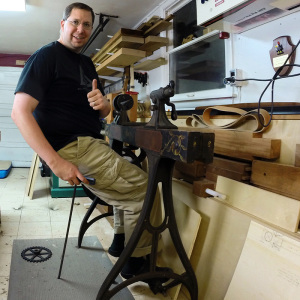Got Any Tips on Machine Restoration, Or I’m Leaving You for an Older Model
“It’s not you, it’s me” I said with a tear in my eye and a guilty weight on my conscience.
“You’re great, but there is someone else…someone older…about 138 years older.”
It was at that point that my newly made treadle lathe walked out in a huff swearing to never talk to me again. I think I heard the pole lathe in the corner sob quietly too.
It was a tough conversation and it didn’t go at all how I wanted it to, but I can’t fight my true feelings. You see when I started volunteering at the Steppingstone Museum almost 5 years ago I fell big time for an 1876 Barnes No 3 Velocipede Lathe. When I began to research lathe designs with the intent of building my own in the back of my mind there was always the thought that what I really wanted was my own Barnes lathe. I put out some feelers and was often disappointed or sticker shocked with that I found. I had pretty much given up on the search and was thrilled with my own efforts to build a treadle lathe that combined old world design with modern efficiency. My lathe worked great and there was no need to look anymore.
That was when the phone rang and an opportunity I couldn’t resist came up that eventually lead to the awkward conversation I had last night while assembling my new Victorian beauty. I sincerely hope to find a place to set up my treadle lathe and I’m not getting rid of it. But with my recent shop remodel and new found space I can’t deny that this more compact lathe fits nicely with the current aesthetic. And I do love the history bound up in this fine example of post Civil War, American industry.
So call me a typical heartless man, but at least I didn’t leave for a younger model right?
So now I turn my thoughts towards making this lathe that I sought after for so long look her best. I’ve never really been the kind of guy that goes for the full restore on vintage tools. I usually just clean them up so they aren’t rusting anymore and get them sharp.
But in this instance, the original manufacturer put so much into the beauty of the machine with delicate pin striping and artwork that I feel like it is my duty to restore all of it to its original state. That being said, I’m definitely out of my element here and I have no experience with even the basics of painting cast iron and applying pin stripe. I have some of my own research in progress but I know I have a lot of readers that have experience here so I thought I would throw it out to the community.
- What is the best product for cleaning up the metal and removing all the gunk?
- Do I need to strip this back to bare metal before painting?
- What kind of paint should I be using?
- Any tips for doing the pin striping: type of paint, application tips? tips for retaining the pattern?
Oh and if you really want to see what this beauty would look like when fully restored, check out the amazing job Ed Hobbs did on his No 3 lathe. I think you can see what I’m shooting for there and believe me I’ve already contacted Ed about it.
C’mon tool restoration experts, help me out
Please share your advice and experience below in the comments, I would love the help.



